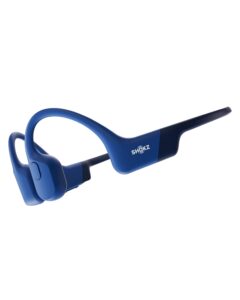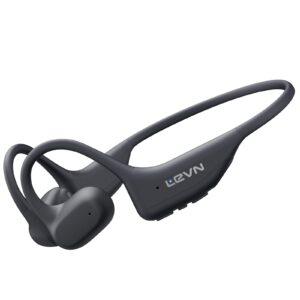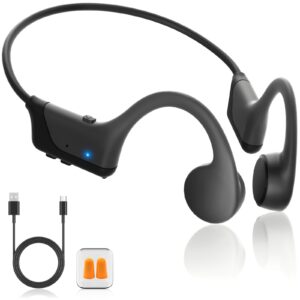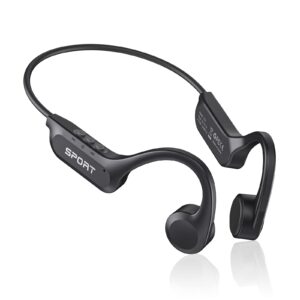We independently select all products and services. If you click through links we provide, Mighty Deals may earn a commission.
Cycling is a popular way to stay fit and enjoy the outdoors, but it can be hard to listen to music or podcasts on a windy day. Many headphones struggle to block out wind noise, leading to a frustrating listening experience. We set out to find which headphones best address this specific problem, allowing cyclists to hear clearly without distraction.
When looking for headphones to use while cycling, wind noise reduction is the main concern, but other factors matter too. Safety is important, so headphones that let in some ambient sound can help you stay aware of your surroundings. Fit, battery life, and comfort are also important, since headphones need to stay secure without becoming uncomfortable on longer rides.
Not all headphones are built the same, and the right model can make a big difference in both comfort and audio quality. We spent hours researching and testing a range of headphones designed to manage wind noise, so you can ride and listen without interruption.
Best Headphones for Cycling Wind Noise
We know how important it is to enjoy your music without distracting wind noise while cycling. Our list features the best headphones that keep sound clear and minimize wind interruptions during your rides.
1. SHOKZ OpenRun Bone Conduction Headphones
If staying alert to your surroundings while cycling is essential, these headphones are a reliable pick for minimizing wind noise without blocking out the world.
Pros
- Open-ear design keeps us aware of nearby traffic and hazards.
- They stay secure even during bumpy rides and sweaty conditions.
- Quick charging means we spend less time waiting to use them.
Cons
- Audio quality takes a hit if it’s very windy.
- Not ideal for those who want deep bass or an immersive sound.
- They aren’t made for swimming or rain-soaked rides.
We appreciate how the SHOKZ OpenRun headphones let us hear both our music and the environment. The bone conduction feature means the wind doesn’t whistle through earbuds, and we never feel isolated from passing cars or other cyclists. That extra awareness is something we value, especially on busier routes.
Wearing them for an extended cycle never leaves us with that pressure or soreness we get from regular headphones. The fit is lightweight and doesn’t shift around. We never had issues pairing with our phones, and it’s easy to take a call or change tracks mid-ride.
Rain isn’t much of an issue thanks to their sweat and water resistance, but we wouldn’t trust them in a downpour. If deep bass is your thing, you may be underwhelmed; these focus more on balanced, clear audio. For everyday cycling where awareness and comfort are priorities, they do the job well.
2. LEVN Open-Ear Bone Conduction Headphones
For cyclists who want to hear music and stay aware of traffic, these headphones strike a great balance.
Pros
- Keeps ears open for full awareness of surroundings
- Extremely comfortable, stays secure on long rides
- Battery lasts well beyond most competitors
Cons
- Sound quality is good but may lack deep bass
- Fit feels a little loose for those with smaller heads
- Can let in a bit of wind noise in very strong gusts
When we took the LEVN Open-Ear Headphones out for a ride, we noticed right away how comfortable and lightweight they felt. They sit gently over our ears, and there’s no pressure or soreness, even after an hour or more cycling. Not having our ears plugged meant we could hear traffic and chat with other riders without constantly pausing our music.
One of the biggest advantages is their long battery life. It’s easy to head out for the day and not worry about running out of power. Pairing with phones and watches is quick, and switching between devices works as expected.
Wind noise is still possible in especially breezy conditions, but overall, these headphones keep outside noise to a manageable level while delivering clear audio. We appreciate how the design allows us to enjoy tunes without sacrificing safety on the road. If you’re after comfort, awareness, and reliable sound for cycling, these are well worth a look.
3. SUNGDOGIN Bone Conduction Headphones
For anyone cycling in windy conditions, these open-ear headphones deliver a solid mix of awareness, comfort, and stable sound for daily rides.
Pros
- Open-ear design keeps us aware of traffic and surroundings.
- Bone conduction tech noticeably reduces wind noise compared to in-ears.
- Lightweight build adds to comfort, even over long rides.
Cons
- Bass response can feel a bit flat outdoors.
- Fit may not be snug on smaller heads.
- Buttons are a touch small for gloved hands.
When we took the SUNGDOGIN Bone Conduction Headphones out on the bike, one of the best features was how the design helped us stay tuned to the road. We never felt sealed off from what was going on around us, which made us feel much safer, especially in urban areas or when riding trails shared with others.
Wind noise was less of a problem than with earbuds or over-ear headphones. The sound came through our cheekbones clearly, so the music or podcasts stayed crisp, while outside noises like cars or other riders were still easy to notice. We appreciated that the headphones stayed in place, even during brisk rides and quick turns.
Wearing these for an hour or two at a stretch never bothered us. The titanium frame felt flexible, and moisture from sweat or light rain didn’t seem to cause any trouble. Charging was fast, and we went several rides before needing to plug in again. If you value staying alert while cycling and want something with a simple, effective design, these are worth considering.
4. CXK Bone Conduction Headphones
This is a strong choice for cyclists who want music without sacrificing awareness or comfort during rides.
Pros
- Keeps our ears open for traffic and sounds around us
- Sits lightly and comfortably, even on longer rides
- Simple controls make changing tracks or answering calls easy
Cons
- Bass and depth in music are limited compared to in-ear options
- Some wind noise can still slip in at higher speeds
- Fit may feel loose for those with smaller heads
Using the CXK bone conduction headphones on our last ride, we found that hearing both music and our environment was effortless. The open-ear design means we stay aware of cars and other cyclists, which is a big advantage.
Comfort stands out—after hours on the road, we barely notice we’re wearing them. They’re light, don’t press too tightly, and never get sweaty or hot. Pairing was quick and didn’t require any complicated steps.
On the downside, riders who prefer booming bass or total noise isolation might be disappointed here. At fast speeds, wind noise becomes more noticeable, especially if the fit isn’t snug. However, for those prioritizing safety and comfort over immersive sound, CXK Bone Conduction Headphones are a practical and reliable option.
Buying Guide
When choosing headphones for cycling, wind noise is a common concern. We should look for designs that reduce this problem. Over-ear and earbud styles both have pros and cons, so it’s important to pick one that suits our preferences.
Key features to consider:
- Fit and Comfort: A snug fit helps block unwanted noise. Adjustable or flexible bands can make long rides more comfortable.
- Wind Protection: Some models use mesh covers or special materials to limit wind noise. Others have built-in sound filters.
- Open-Ear Design: These headphones leave our ears open, allowing us to hear traffic and stay aware.
Here’s a simple table of features to assess:
| Feature | Why It Matters |
|---|---|
| Secure Fit | Prevents slipping during rides |
| Battery Life | Longer rides need longer battery support |
| Sweat Resistance | Handles moisture from sweat or rain |
| Button Controls | Easier to change tracks while riding |
| Sound Isolation | Can help with noisy environments |
It’s also wise to test them in real riding conditions if possible. We should check how easy it is to adjust volume or pause music while on the move.
Lastly, considering the price and warranty matters. Affordable options can offer good value, but we should also look at durability and support. This helps ensure we get a pair that fits our needs and lasts.
Frequently Asked Questions
We often hear from cyclists looking for headphones that handle wind noise well and perform reliably on rides. Our focus is on comfort, sound clarity, secure fit, and effective noise reduction.
What features should we look for in headphones to reduce wind noise while cycling?
We should look for headphones with a snug fit, aerodynamic design, and wind-proof mesh. Some models also include specific noise reduction technology and ergonomic shapes that limit wind entering the ear canal.
Which bone conduction headphones are recommended for minimizing wind noise?
Bone conduction headphones typically sit outside the ears. Models like the Shokz OpenRun Pro come with open-ear designs that reduce direct wind contact and provide stable, skip-free listening at moderate speeds.
Are there specific earbuds that come with wind noise reduction for cyclists?
Some earbuds offer adaptive noise cancellation and wind-reducing ear tips. The Jabra Elite 8 Active and Bose QuietComfort Earbuds II both have ratings for noise isolation and test well for wind management, especially when used with cycling helmets.
How do open-ear headphones perform against wind noise during bike rides?
Open-ear headphones generally allow wind noise but are safer for traffic awareness. We find some models with wind-reducing materials or side shields can improve audio clarity, but most do not fully block wind.
What are the top-reviewed headphones for use with a bike helmet regarding wind noise?
Shokz OpenRun Pro, Jabra Elite 8 Active, and AfterShokz Aeropex are often praised for helmet compatibility and stable fit. These options have consistent user feedback for staying put and maintaining usable sound quality in breezy conditions.
Can we recommend any headphones with a quality microphone that suppresses wind noise for cycling?
The Jabra Elite 8 Active and Shokz OpenComm feature microphones with wind shields and noise filtering. These models work well for phone calls and voice commands without excessive wind interference, even while riding.





